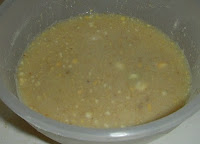

INGREDIENTS:
Eggplant 1( Big)
Tamarind big lemon size
Salt as per taste
Jaggary 1 table spoons (powdered)
Red chilys 8 to 10 (as per taste)
Celantro for garnishing
Seasoninig:
Oil 1 tbl sp.
mustard seeds 1 tsp
Heeng 1/4 tsp
Fenugreek seeds powder 1/2 tsp (dry roast and grind)
Preparation:
1. Peel eggplant and microvave for 5 to 8 minits or cook in a pan./(roast it directly on the flame using wire mesh).
2. Soak tamarind for 30 min and make thin puree and keep aside.
3. Heat small pan add little bit oil and fry red chillyis.
4.Take tamarind water in a bowel and add Fri.ed red chillies (mashed)
5. Add jaggary, salt to the tamarind water.
6. Add cooked and mashed eggplant to the mixture.
7. Heat oil in small pan add mustard seeds when it splutter add heeng and fenugreek powder.
8. Add to the mixture and mix well and garnish with cilantro and serve.
This can be eaten with rice or roti.
1.Variations..
Instead of egg plant, you can use onions.
1. cut onion into small pieces.
2. fry it in a little oil untill they get soft.
3. add this in the tamarind juice.
4. rest is as above.
(Refer to Ullipaya pacchi pulusu for detail).
2.Variation..
1.white pumpkin vadis can be fried and can mixed in the tamarind juice.
2. rest is as above.




























